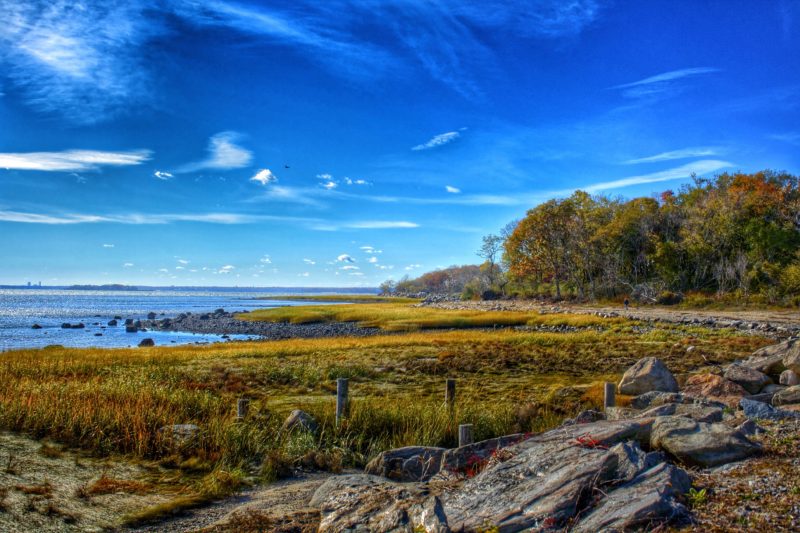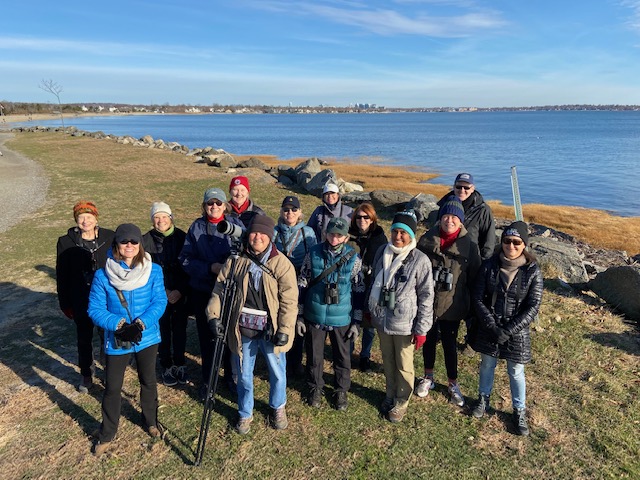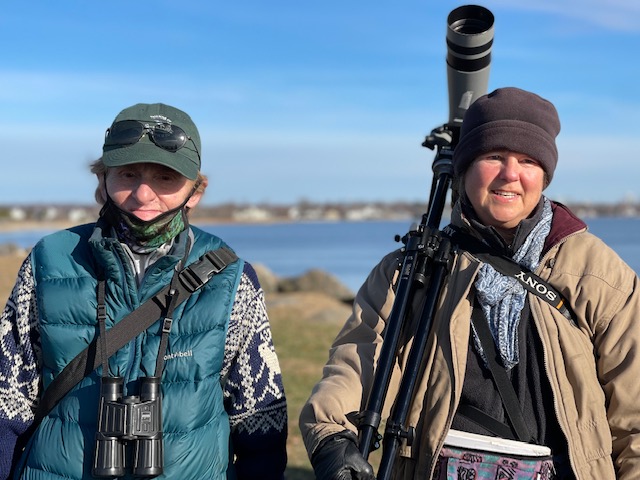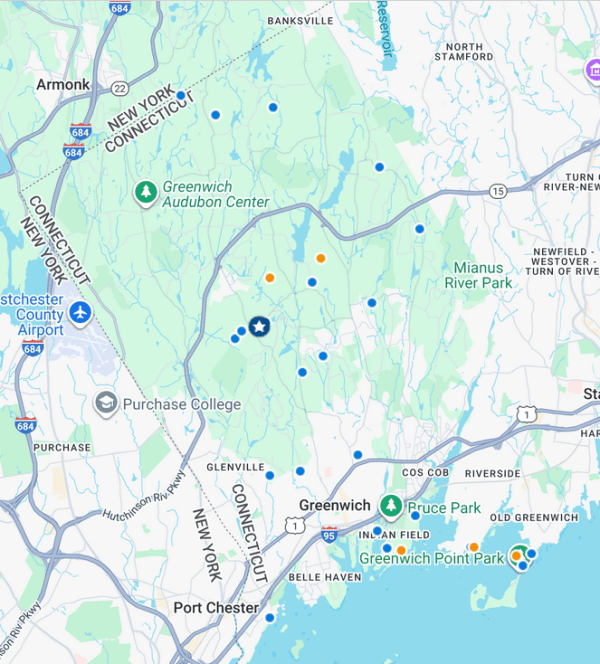
By Anne W. Semmes

Greenwich Point with its 47-plus acres of beaches, woodlands, and marshes is a favorite destination for nature lovers, walkers, and bikers. But, lately, in this pandemic, there’s been a steady influx of birdwatchers. “People have wanted to get outside and do things outside, so this is just another outlet for them to kind of appreciate what is in their local environment.”
So says veteran birdwatcher, Cynthia Ehlinger who has in her 26 years of counting birds on Greenwich Point listed 236 bird species of a reported 310 species reported on eBird. And as of 2022 Ehlinger will be co-leading with First Sunday founder Meredith Sampson the 18th year of First Sunday (of the month) Bird Walks that now has a devoted following with birders coming from afar a field as the Bronx to Hartford and beyond.
Those out of town birders have Ehlinger and Sampson to thank for opening the Greenwich Point door. “Initially, we were saying people from outside town would have to get a beach card,” says Ehlinger, “But now I have been getting permits from the town of Greenwich to allow anybody who does not have a beach card. So, they can come in at any time of the year. So that’s been very helpful.”
With the size of the birder groups growing in the pandemic, says Ehlinger, “We initially had to keep the groups to a very limited size.” Those CDC mask recommendations had to be adhered to. “We had to split into two groups, and at one point into three because when you get up above 12 people or so it’s better to be in smaller groups. When we go along the shoreline in the wintertime, it’s not as much of a problem – we can spread out. When we have spring migration with looking at warblers, and everybody wants to see the same thing, it’s better if we split into smaller groups.”
Apparently, cold weather does not discourage these birdwatchers. For Ehlinger, who walks Greenwich Point near daily, “Every day is a nice birding day.” And Sampson recalls that First Sunday walk in 2004 as snowy and sleety. “There were four attendees, but we held tough and birded for over an hour and a half!”
Sampson adds, “Until Covid hit, we missed only one Sunday when Superstorm Sandy struck and the Point was closed for over three weeks. – a great track record for 16 years.”
So, what are those stalwart birders seeing this wintertime? “Definitely the Bald Eagle,” says Ehlinger. “We definitely have resident bald eagles now that are showing up. They like to hang out at one particular tree in the first parking lot. I’ve seen two adults on the tree and a lot of times just a single one and there’s also at least a juvenile hanging around in the area as well. I’m aware of two nests along the shoreline that have been used by eagles.” And those eagles she says just might be considering taking over an osprey nest.

“You can see an Eagle at the Point now almost every day,” confirms Sampson. “I was down there last Saturday with new people bringing down their Christmas trees. Here’s this big adult Eagle sitting in a dead tree right by where you dump your Christmas tree in the parking lot. And people are walking by totally oblivious, and I said, ‘Did you see the Eagle?’ ‘No! Where?’ Oh my god – they’re running over there with their cell phones to take pictures.”
But there was another bird last weekend that brought Sampson joy. “I had a Fox Sparrow, a beautiful little bird you only see during the winter. Not terribly common. But there it was foraging under a pine tree where there was bare ground and snow everywhere else.”
Sampson, who wears another hat as wildlife rehabilitator with her Wild Wings concern, sees that effort “beautifully dovetailed with being a birder because you need to know the natural histories of the species you’re working with. Not all birds eat seeds, things like that. I am very passionate about nature and try to convey to people we’ve got to take care of good old mother earth.”
To that end Sampson serves as consultant to the Friends of Greenwich Point (FoGP) – where Ehlinger also serves as advisor. “I’m just encouraging,” says Sampson, “biodiverse habitats and native plantings, trees, plants, grasses, native, native, native. If you’re going to dig out all those invasive non-native plants, you’ve got to put right away native plants, so non-natives don’t regrow. As the saying goes, nature abhors a vacuum.”
“Learning about birds and appreciating birds gives FoGP good reason to put so much energy into eradicating invasive species at the Point,” confirms FoGP board member, Patty Nizlek. “Our connection to Nature, and our responsibility to live in harmony with Nature, are deepened and strengthened each time we learn and appreciate more about birds, which is facilitated for us by the leaders of the First Sunday Bird Walks.”
Both Ehlinger and Sampson point to their moms as positive influencers of their interest in birding. “I used to go out with my mother when I was 10 or 11 years old,” says Ehlinger,” and she would take me with her on the Christmas Bird Count. My job was to keep the tally.” Sampson tells, “My mom was a big animal lover as well…I just loved being outdoors. Being outdoors was kind of my refuge.”
Sampson sees the ongoing value of those First Sunday walks. “Doing the bird walks is one way of trying to help people get connected with the natural world. And to start caring to respect it, and to admire it. Because it’s what sustains us, gives us sustenance, and on many levels, we can’t survive without nature. And right now, Nature needs our help too. It can’t survive without us.”
“Birds are like the proverbial canary in a coal mine,” says Sampson. “If you see a species taking a precipitous decline, you know there’s something going on in the environment.” She tells of that precipitous decline of crows with the arrival of the West Nile virus. Today, she cites, “Most species and numbers have dropped in the last 10 to 20 years…It really has intensified within the last five years.”
But those moments of joy still surprise. Ehlinger recalls that daily walk two years ago of coming upon five warblers on an Elm tree. “You know it’s a good day for birding,” she tells, “when five warblers of three species Blackpoll, Black-throated Blue, and Magnolia Warbler show up on a tree trunk within inches of each other! I wanted to share it with anybody that came by because it was just so amazing to see all these birds on this tree.”
For Sampson, the joy continues of years ago spotting that snowy owl atop the Innis Arden Cottage. “So, there were all these people coming in – it was a beautiful day. And I’m setting up my birding scope so people can look and see this incredibly beautiful bird. They do show up in the winter but it’s rare when they show up at the Point. So, I just stopped people that were walking by, high school kids are going through. ‘So, you want to see something so incredibly beautiful? Take a look.’ And they look in the scope. ‘Whoa, what is that?’ I tell them. I give them a little bit of natural history. I mean, my god there he was hanging out on the chimney. It was just one of those incredible teachable moments, talking to people, and thinking, I hope I opened up some eyes.”
The First Sunday Bird Walks meet at 9 a.m. at the Greenwich Point main concession stand at the south end of the beach.





